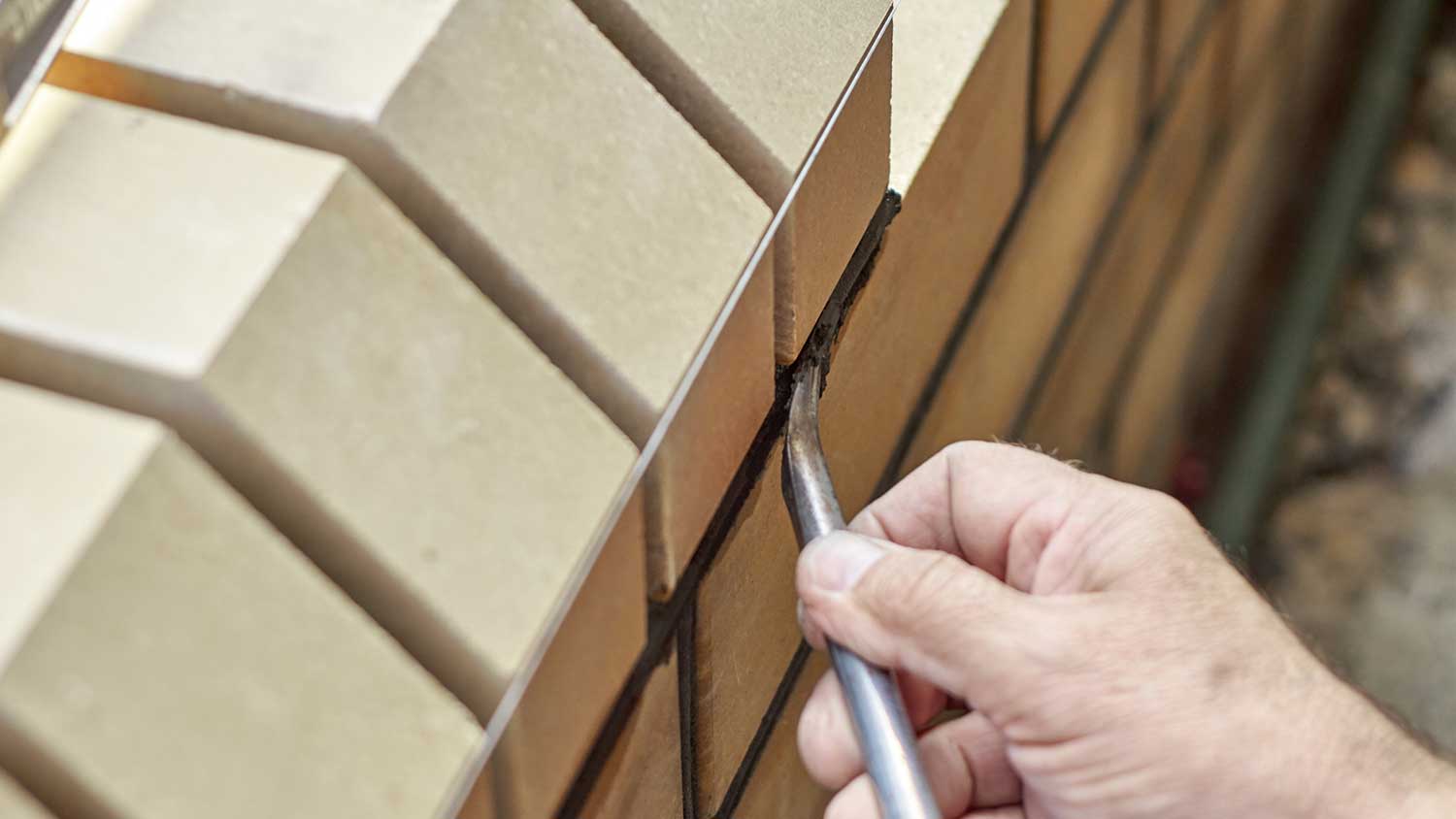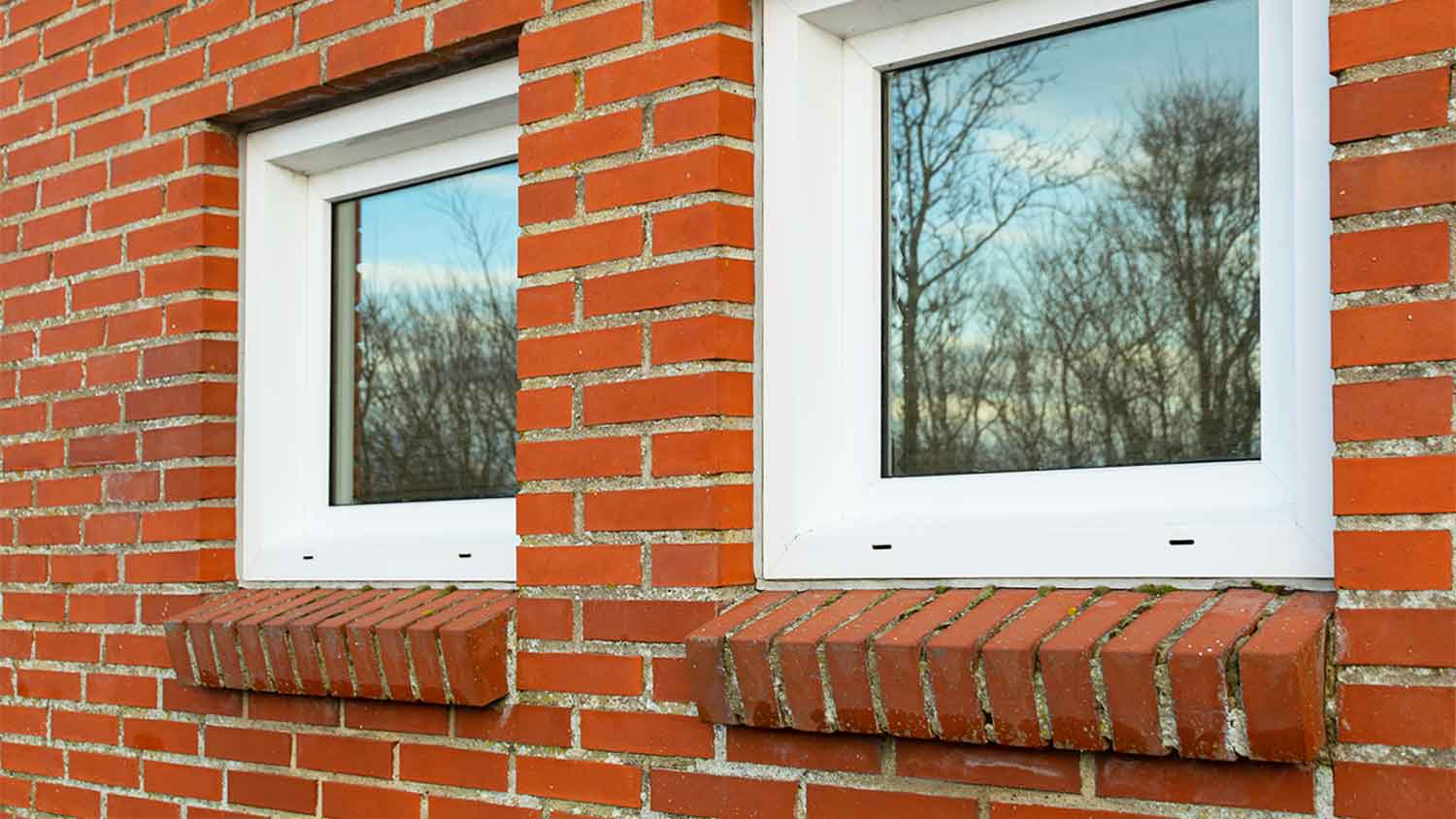How to Install Brick Veneer Siding in 13 Steps
Brick veneer adds a luxurious aesthetic to your home—but installing it yourself is tough


- Trowel
- Masonry saw
- Staple gun
- Chalk line
- Story pole
- Bricks
- Mortar
- Stone sills (optional)
- Felt wrap
- Staples
Brick veneer siding can enhance the curb appeal of your home—it mimics brick walls but is only one layer thick, saving on overall costs. Brick veneer offers numerous advantages beyond just the aesthetics, however; homeowners choose brick veneer because it’s water-resistant, a good insulator, efficient, and affordable.
Wondering how to install brick veneer siding? It’s certainly more doable than constructing a complete, multi-layer brick wall on your own—but it’s still highly complicated for even the most DIY-savvy homeowners. We recommend working with a stone veneer contractor near you for a correctly installed brick veneer wall. Contractors can ensure a better final product: one that’s more aesthetically pleasing and more likely to prevent water damage, especially around windows.
If you’re handy around the house and have some experience laying brick, you can try to take on the installation on your own. Prepare yourself for a complicated project that, if covering your entire house, could take you weeks to finish. Still up for the challenge? Here’s how to install exterior brick veneer on your home in 13 steps.
Prepping to Install Brick Veneer
Before you can install brick veneer siding on exterior walls, you’ll need to remove the existing siding, which is a project in and of itself. Old siding removal doesn’t add anything to the siding replacement cost if you’re DIYing the whole project, but you can always hire a local siding contractor to handle this part of the project if you’re short on time.
You’ll also need to remove moldings from around your doors and windows. Once the siding and molding are off, you’re ready to roll up your sleeves and get to work.
Apply a Moisture Barrier
 Photo: Lex20 / iStock / Getty Images Plus / Getty Images
Photo: Lex20 / iStock / Getty Images Plus / Getty ImagesTo prevent water from getting into your home, install a moisture barrier—a 15-pound felt wrap—to the existing sheathing on the wall. Use staples to fasten it into place, and cut openings for windows, doors, and air vents.
Mark the Felt Paper
Use a story pole to indicate the tops and bottoms of window and door openings. You’ll need to ensure proper spacing to install rowlocks or stone sills around these openings. You’ll also want to use your story pole to indicate every fifth row of bricks; you’ll need to pay attention to these rows when it’s time to install corrugated brick ties.
If you don’t have a story pole, you can create one using a spare piece of lumber, measuring tape, and a pencil.
Install Angle Iron at the Base
 Photo: mathisa / Adobe Stock
Photo: mathisa / Adobe StockTo form your base row (called a “course”) of brick veneer, you’ll need to attach an angle iron along the foundation. This will support the first layer of bricks.
Snap a chalk line along the foundation wall to ensure a straight installation. Measure the length of the wall and cut your angle iron to size with a chop saw. Drill holes into the iron at 1-foot intervals. Then, using a measuring tape, drill matching holes along the chalk line on the foundation and insert lag shields.
Prop up the angle iron against the foundation wall, and fasten it into place using lag screws.
Spread the Mortar for the First Few Bricks
Lay a 1-inch-thick bed of mortar along one end of the angle iron, roughly two to three bricks wide. Drag the trowel along the center of the mortar to form a depression (called “furrowing”).
Lay the First Brick
Starting at the edge of the wall, install your first brick. Leave precisely ½ inch of air space between the foundation and the edge of the brick. Press the brick firmly into the mortar, leaving a mortar bed that is ⅜ inches thick.
Use your trowel to trim off the excess mortar. You can mix this back into the mortar bucket or apply it a little farther down the angle iron for future bricks.
Lay Additional Bricks on First Course
 Photo: Lex20 / iStock / Getty Images Plus / Getty Images
Photo: Lex20 / iStock / Getty Images Plus / Getty ImagesContinue along this first course, laying several more bricks. Be sure to apply mortar between the bricks (called “buttering”), also at ⅜-inch thickness. At four-brick intervals, use your level to ensure you’re installing in a straight line (this ensures your mortar bed is consistently ⅜ inches thick).
Strike Mortar
 Photo: marketlan / iStock / Getty Images Plus / Getty Images
Photo: marketlan / iStock / Getty Images Plus / Getty ImagesAs you move along, check your mortar under and between laid bricks to see if it’s ready for striking. The mortar needs to be set part-way but not completely dry. At that point, strike it with your concave jointer.
Let more time pass so the mortar can completely set up, then return to it to remove the excess with a brush. Use a wet rag to wipe off any smears on the bricks themselves.
Create Weep Holes
As you continue down the course, you’ll need to create weep holes. These allow water to drain out from behind the brick, which prevents water damage, mold, and mildew.
You can create weep holes by placing a cord (¼-inch thickness) in the mortar between two bricks. Do this about every 2 feet along the course (and subsequent courses). As the mortar starts to set, tug the cord out, and you’ll have a small weep hole for water to drain.
Build Up Ends of Walls
 Photo: SimplyCreativePhotography / iStock / Getty Images Plus / Getty Images
Photo: SimplyCreativePhotography / iStock / Getty Images Plus / Getty ImagesBefore you completely finish the first course, you’ll want to return to the ends of the wall to start building up multiple courses (called “building the leads”). Start every other course with a half brick, which ensures each row is offset from the row above and below it.
Finish the First Course
After you’ve built the leads, you can finish your first course and work your way up. Use a masonry line block to ensure your rows remain level as you move up the wall. You can also use your level to ensure you’re on the right track.
When installing the final brick of any course, butter both ends with mortar. If you’ve measured ahead and kept your mortar thickness consistent, it should slot right in, but you can always trim your brick with a masonry saw as needed.
Nail Corrugated Brick Ties
For extra stabilization, you’ll need to install corrugated brick ties at every fifth course. Use a stud finder to locate each stud along the wall and install the brick tie at each stud interval.
Brick ties are L-shaped. You’ll place the bottom of the L along the brick below it, with the top of the L butted up against the moisture barrier with the stud behind it. To install, nail the brick tie into the stud, then mortar over the bottom of the brick tie and install your next brick on top of it.
Depending on the height of the walls, you may need a ladder or scaffolding.
Create a Rowlock Beneath Windows
 Photo: ANDA / Adobe Stock
Photo: ANDA / Adobe StockIf you’re installing brick veneer around windows, you’ll likely create a rowlock beneath the window. (Alternatively, you can purchase and install stone sills.)
To get the right angle of the rowlock, use a T-bevel to measure the angle of the window sill. Transfer it to your bricks and cut them at that angle.
Install these cut bricks beneath the window. Ensure they’re angled slightly down so that water runs away from the window.
Install Angle Iron and Flashing Above Windows and Doors
Above windows and doors, you’ll need to install another angle iron. Cut it roughly 4 inches longer on either side than the length of the opening. Attach it above the window, install metal flashing, and then create a rowlock course on top of the flashing.
DIY vs. Hiring a Pro
Installing a brick veneer wall is not a task to be taken lightly. Unless you have prior experience working with masonry and exterior walls, we highly advise working with a professional. Professional siding installation pros will work faster and more accurately, leaving you with a more aesthetically pleasing wall—and one less likely to create water damage.
If you’re hoping to do the installation yourself, you might want to consider another type of siding—one that is easier to install on your own. See how brick and brick veneer stack up against other common siding options:
Frequently Asked Questions
You install brick veneer walls using a single layer of brick, with mortar between each brick. Your base course (or row) is installed to an angle iron that is fastened to the foundation. Then, every five courses up, you’ll also fasten the brick veneer to the studs using corrugated brick ties.
Installing a brick veneer exterior wall yourself is possible, but you should only attempt it if you have prior experience working with masonry and siding. It is a challenging, multi-day project (especially if you’re installing brick veneer over the entirety of your home). In most cases, it makes more sense to hire a contractor to install brick veneer siding.
Brick veneer siding can last 50 to 100 years if properly installed and maintained. That’s why it’s important to hire a siding professional to install your brick veneer siding rather than tackle the job yourself. To maintain your brick veneer siding, scrub it once a year using a special detergent and a soft-bristled broom or a special attachment for your garden hose. You should also inspect bricks closely and hire a local masonry contractor for repairs to worn mortar or bowing bricks.
The most obvious alternative to brick veneer siding is a true brick wall. However, you can also explore cost-effective alternatives to brick veneer, including stone veneer siding, engineered wood siding, and fiber cement siding. Hardie board is another popular option for its high quality; Hardie board siding costs $17,500 on average, however. Vinyl siding is a more affordable option, but it’s significantly less durable than brick veneer. Explore the various types of vinyl siding—and their pros and cons—before committing.




















